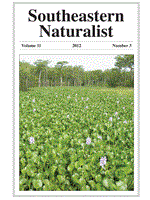As a result of declining populations and reduced availability of suitable habitat, Ambystoma bishopi (Reticulated Flatwoods Salamander) and A. cingulatum (Frosted Flatwoods Salamander) are federally listed as endangered and threatened, respectively, by the United States Fish and Wildlife Service under the Endangered Species Act. Recovery efforts are hindered by a lack of basic natural history information. Although the fossorial life history of ambystomatid salamanders often precludes direct observation of adults and juveniles, an incidental encounter of A. bishopi climbing on Aristida stricta (Wiregrass) sparked a new search effort. On 13 occasions from 29 April 2010 to 23 November 2011, we examined herbaceous ground cover in and around six known breeding wetlands in the Florida panhandle, documenting 36 observations of flatwoods salamanders (10 adults and 26 juveniles), 30 of which were climbing up to 0.5 m above the ground in Wiregrass. These observations led us to hypothesize that Wiregrass, a fire-dependent grass species associated with flatwoods salamander breeding habitat, may be used by juvenile and adult flatwoods salamanders as a foraging substrate (foliage) and/or as refugia (foliage and root base). Although these observations are interesting, further research is needed to determine if the salamanders are selectively using wiregrass and if a foraging and/or refugial advantage is gained by climbing.
How to translate text using browser tools
1 September 2012
Climbing Behavior of Flatwoods Salamanders (Ambystoma bishopi/A. cingulatum)
Kelly C. Jones,
Pierson Hill,
Thomas A. Gorman,
Carola A. Haas
ACCESS THE FULL ARTICLE

Southeastern Naturalist
Vol. 11 • No. 3
September 2012
Vol. 11 • No. 3
September 2012




